Six Days in Chengdu Du Jiang Yan Le Shan Emei Sichuan China

Earlier this year, we were invited to explore Sichuan China. It was organized by Hong Kong China Tourism and Tourism Sichuan. This is our first time visiting this part of China as we explored Lijiang last year. We will be posting highlights of this six days travel in Chengdu,Du Jiang Yan, Le Shan, Emei in Sichuan China.
Travel in Sichuan Day 1 – Kuala Lumpur to Chengdu
Flying from Kuala Lumpur direct to Chengdu via AirAsia. The flight takes four hours 25 minutes from Kuala Lumpur International Airport 2 to Chengdu International Airport. The flight starts from 6.15pm and we reached Chengdu around 10.40pm.
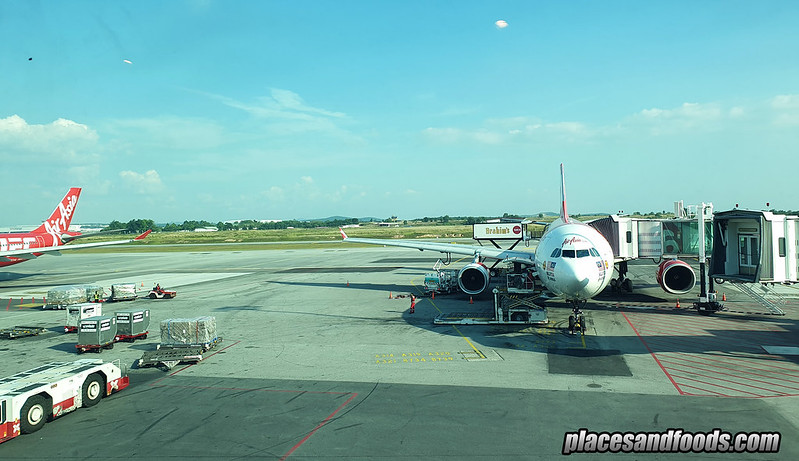
Once we touched down, the tour guide took us to the hotel and we stayed at Shimao Yuluxe Hotel. It is a luxury boutique hotel located in Chengdu downtown. We reached the hotel around midnight, took a night shower and getting ready for travel on the next morning.
Travel in Sichuan Day 2 -Chengdu to Du Jiang Yan
We had breakfast in the hotel and time to visit the pandas. For your information, Sichuan is the home of the iconic animal of China, the pandas. To visit the pandas, we went to Chengdu Research Base of Giant Panda Breeding.
Chengdu Research Base of Giant Panda Breeding 都大熊猫基地
This is our first stop in Chengdu and the Chengdu Resarch Base of Giant Panada Breeding is huge. We spent around two hours and we only explored parts of the research base. During peak season, this research base is packed with tourists and visitors.

The Chengdu Research Base of Giant Panda Breeding is located 10km from the Chengdu city centre. This place is like Pandas wonderland or playland. There are hundreds of pandas in this place.

We went to see Pandas in Macao many years ago and this is the first time we see so many pandas in one place.
You get to see all sorts of pandas here and lucky for us, they are very active and playful. Some pandas were sleeping and some even had hangover on top of the tree.

This is the place you can bring your kids to see the pandas and we are very sure they will love the pandas. They are adorable and cute. This is a must visit place in Chengdu.
Lunch at 农家小院 Nong Jia Xiao Yuan
After visiting the pandas, we went for lunch at 农家小院 Nong Jia Xiao Yuan for authentic homestyle Sichuan food. For those who travelled to China with tours will know that meals in China are extravagant.

Usually lunches or dinners will come with seven to eight dishes per meal. For this lunch, we had chicken, pork, beef, fish and vegetables. Food in this part of China offers a lot of spiciness and thus it is similar to Malaysian cuisine in a way. If you are big fan of spicy food, please visit Sichuan China.
San Xing Dui’s Ancient Bronze Museum 三星堆博物馆
The second stop of the day is San Xing Dui’s Ancient Bronze Museum 三星堆博物馆. This unique museum is located 70km from Chengdu.

This is for history lovers as you can spend hours understanding advanced ancient civilisation here in this part of China.

There are many exhibits and collections of Bronze Age artifacts dating back 3000 years at San Xing Dui. Thus, the Shu Kingdom is one of the cradles of the world and Chinese civilisation.

There are many unique and interesting artifacts and collections will blow your mind. There are hearing aids available in this museum. What is interesting is the tools and artifacts of the past especially the weird looking masks. It looks so ‘alienish’ and there are similar masks in other parts of the world! This really makes you feel that we are not alone in this universe.
Dinner at 烧蹄花 都江堰 Du Jiang Yan
This is another feast at this local restaurant called 都江堰 in Du Jiang Yan. Sichuan is popular with signature dishes like ‘mala’ (spicy with numbness aftertaste) hotpot and ‘ma por’ toufu.

We got the taste the ‘original’ mala toufu here but they serve the tofu in slices which is quite interesting. The taste is really good but hot and spicy.

Overall the food here is spicy and for spicy food lovers, this is heaven. No wonder, they called Sichuan as the gastronomy province of China.
Du Jiang Yan City
This is the interesting part of Du Jiang Yan Old City. The river is brightened with blue lights and it turns the city bright and vibrant.

We walked around and explore the city as it was very relaxing in late February. It was windy and cooling and we were walking after the heavy dinner like the locals.

There are many locals singing in the street with stand alone karaoke system. It seems to be a popular activity here at Du Jiang Yan City.

We had Mala Rabbit Head for supper and stayed in Holiday Inn Plaza in Du Jiang Yan (formerly Holiday Inn Express).
Travel in Sichuan Day 3 – Du Jiang Yan to Le Shan
Breakfast is usually in hotel and we checked on, sit on the coach and will be traveling to Le Shan, another city in Sichuan.
Mount Qingcheng and the Dujiangyan Irrigation System
This is the first stop on the third day and we spent quite some time here. Mount Qingcheng and the Dujiangyan Irrigation System is a huge place.

Mount Qingcheng, dominating the Chengdu plains to the south of the Dujiangyan Irrigation System, is a mountain famous in Chinese history as the place where in 142 CE the philosopher Zhang Ling founded the doctrine of Chinese Taoism.

The other interesting part of Dujiangyan Irrigation System is the ancient irrigation works dating back to 300 BC.
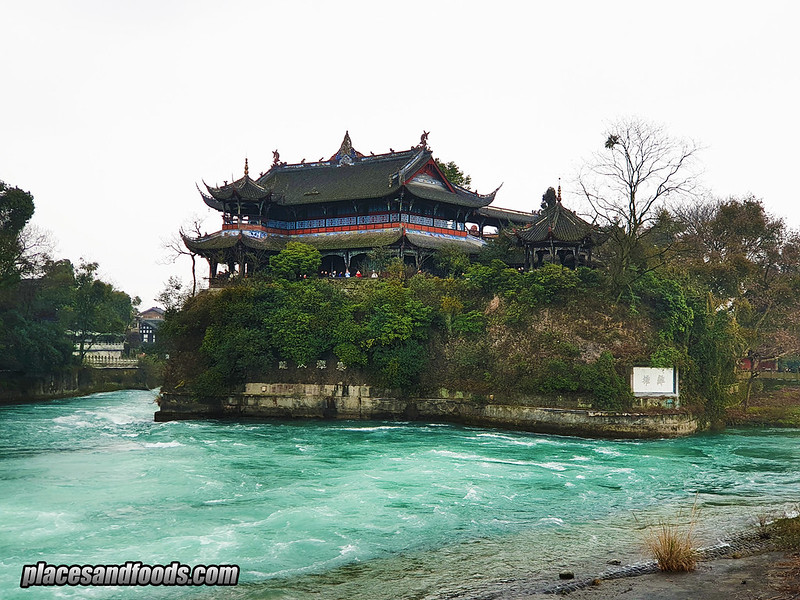
This irrigation system is built by Li Bing to divert water to a few different rivers to control flooding in this plain.

Li Bing used bamboo, wooden logs and stones to calm the Du Jiang River by diverting the water to different rivers which leads to Du Jiang Yan city. When the water level of the river rise to certain height, it will naturally divert to other two rivers and by using this technique, the cities in the valley won’t be flooded. This is truly an ancient marvel. Mount Qingcheng and the Dujiangyan Irrigation System is listed in UNESCO Heritage Site List in 2000.
Chuan Cai Museum川菜博物馆
Our lunch is at Chuan Cai Museum川菜博物馆. This is a popular cooking school in Sichuan and we have to cook our own lunch.

We had to cook three dishes and they are kung po chicken, ma po to fu and red bean bun. It is a fun thing to do and this is similar to other cooking classes we attend like the Blue Elephant in Bangkok Thailand.
At the end of the day, we screwed up in the red bean bun but the other dishes are tasty and delicious.
Le Shan Giant Buddha 乐山大佛
Visiting Le Shan Giant Buddha 乐山大佛 is a dream comes true as it was featured in Hong Kong’s Storm Rider the movie. The Le Shan Giant is 71 metre tall and it is built in between 713 to 803 during the Tang dynasty.

The history of this giant Buddha is long but currently it is undergoing restoration and maintenance work. Thus, we were not allowed to land on the island to see the giant Buddha up, close and personal.
The site of Le Shan Giant Buddha is just five minutes cruise from the pier and it is surrounded by modern buildings. Developments have reached this part of Le Shan. Le Shan Giant Buddha is listed under the UNESCO Heritage Site List.

The giant Buddha statue was built on a red limestone cliff on Min Jiang River. It is believed that it was built to bless travellers using the treacherous river – it turned out that the stones chiselled off the cliff to make the huge statue fell into the water, flattening the uneven river bed, hence calming the waters. The Buddha statue was undergoing restoration when we were there but we can still appreciate the grandeur and aura of the UNESCO Heritage site.
Dinner at Le Shan Hotpot Restaurant 房房燭火鍋
Finally, our first ‘mala’ hotpot. We had it at this popular hotpot restaurant called 房房燭火鍋. There are many ‘mala’ hotpot restaurants and they offer option of ‘mala’ soup and other soup. We had twin soup with herb soup and ‘mala’ soup. We can’t take spicy so herb soup is good for us.

They serve many funny dishes such as goose intestines, duck tongue, rabbit stomach and more. We tried some of the unique dishes but we stick to the usual beef, pork, pork and chicken.
What is interesting is they gave us cans of vegetable oils and it is used as dipping for ‘mala’ hotpot. These oils intensified the spiciness but this is good stuff!
Stayed at Ramada Le Shan Hotel
This is one of the best hotels we stayed during this trip and sadly we only stayed for one night and reached hotel after dinner.

The ‘mala’ after effect happened today. Body got really heat
up and it was really hard to sleep to be honest. We heard many stories on the
‘mala’ after effect and it hits me hard. I didn’t have a good sleep as the heat
borders me.
Travel in Sichuan Day 4 – Le Shan to Emei
Starting the fourth day with breakfast in hotel and today, we will be traveling from Le Shan to Emei.
Jiayang Steam Train 犍为小火车
First stop for the fourth day is to ride on Jiayang Steam Train. This is the oldest steam train in the world at Jiayang. We went on ride on similar train in Ushuaia Argentina many years ago but this is different. The train ride in Ushuaia is called The Ride To The End of The World.

It is the old steam train and the train carriages are made from wood. You have to purchase tickets to take a ride in this train.
This feels like in those old Chinese movies where people sit in these steam trains to travel in between cities in China. The amount of steam released is unbelievable, it white plumes of steam covered almost the entire train.

What is interesting about this train ride is we get to see fields of beautiful golden yellow rapeseed blooms. Trust us, the girls will love these yellow rapeseed blooms as they are so instagrammable.
Taking the steam train is like a trip back to the past and the next destination is Bajiaogou Coal Mine.
Bajiaogou Coal Mine

This is one of the most interesting places we have been in China. The Bajiaogou coal mine feels like 1960s. The architecture of the buildings as well as the posters and paintings of Mao Ze Dong is still there.

We feel like stepping back during the 1960s in Bajiaogou Coal Mine. The buildings, the tiles and even the trees, it still remained the same in 2019.
Lunch at Bajiaogou 礦工食堂
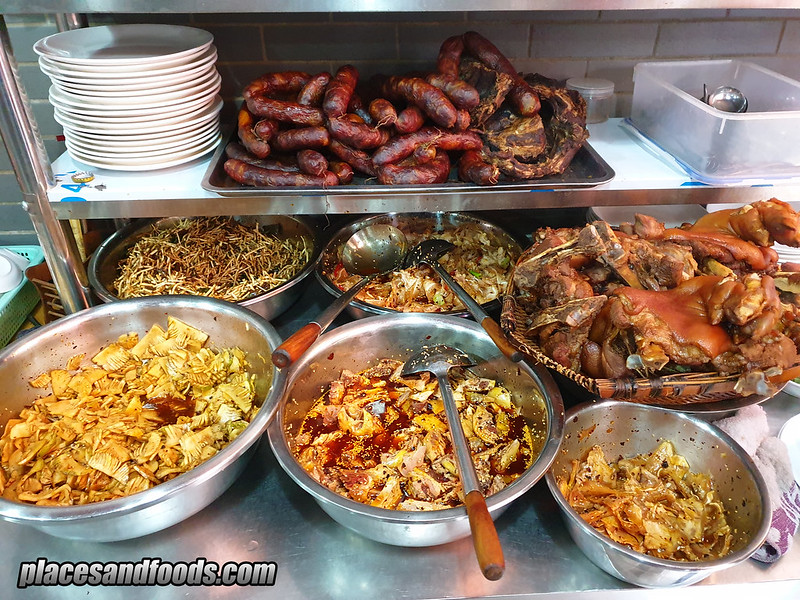
The lunch reflects the food that miners ate in Bajiaogou Coal Mine’s heydays in the 1960s. Most of the food are meaty as it offers energy to coal miners for the entire day. Here, we eat like the locals and the food here is pretty decent.
Bajiaogou Old Cars Transportation

We are not taking the train back to the city and instead we are riding one of these Bajiaogou old cars back to our coach. We love how they maintained the cars and making it part of the tourist activities / attractions for Bajiaogou.
Luo Cheng Ancient Town 罗成古镇
The next stop is Luo Cheng Ancient Town. This is a rather unique ancient town compared to ones we went in Yunnan China.

The Lou Cheng ancient town is dated back to the 1600s during the Ming Dynasty era. It is packed with locals and this has become a meeting point for the locals.
You can find many locals playing card games, playing mah-jong, chit chatting with friends while enjoying a cuppa tea.
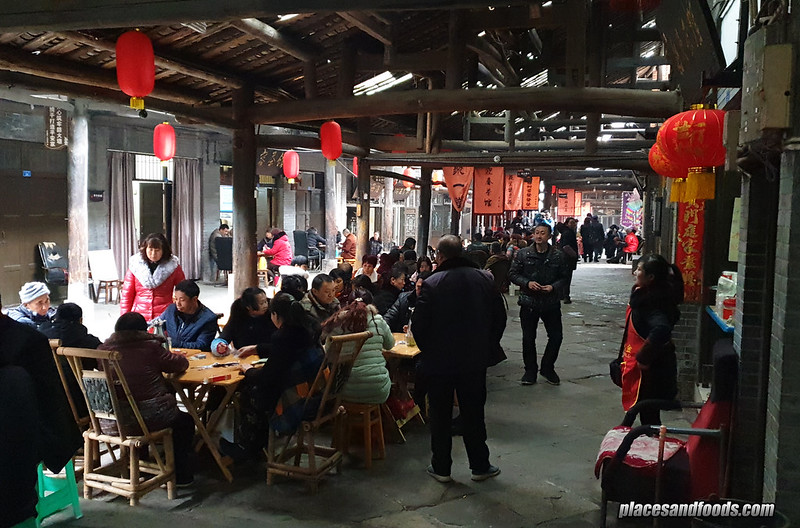
The architecture of this ancient town is unique as from the top, the town is actually a boat shape. The ancient towns in Yunnan are usually octagon shaped towns.
The structures here are built with woods and not stones. The ancient town is not that touristy too as it is crowded with locals.
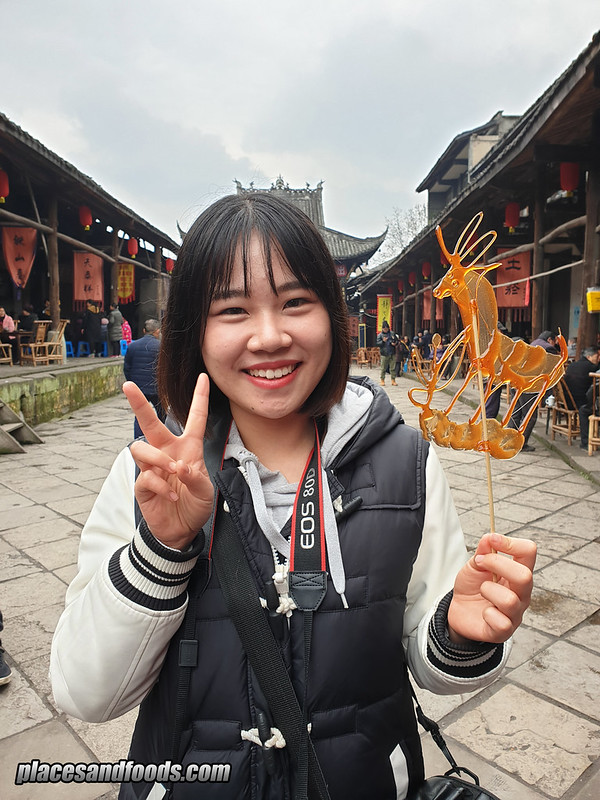
There ia some street food here and this ‘sugar painting’ stick caught our attention as the store owner uses hot caramel to draw paintings on the stick.
Dinner at Emei City 醉峨眉
This is another glorious dinner in Sichuan and we had dinner at Emei City in this restaurant called 醉峨眉.

The food in Emei City is similar as other cities in Sichuan and they used a lot of chilies and ‘mala’ in their dishes. The ‘mala’ noodle is delicious but it is spicy.
There were also other local dishes and rabbit stewed with tomatoes. The locals really love rabbits.
They have one local dish which is similar with our Malaysian appam balik but their version is bigger.
Emei Kung Fu Show at Emei Performing Arts Centre 峨眉山演艺中心
For those who read Chinese fiction stories, Emei is a popular for its legendary Kungfu clan. There are three strongest kung fu clans in China which is Shaolin, Moudong and Emei.

Many TV dramas and movies portrayed Emei as one of places for kung fu but in actual fact, it is just fiction. We don’t find any kung fu clans in Emei but we watched the Emei Kung Fu Show at Emei Performing Arts Centre 峨眉山演艺中心

This is not really a Kungfu show but it is more like an acrobatic show, comedy stunts and face mask changing show.

The Emei Kung Fu Show in short is very entertaining, comedic if you understand ‘Mandarin’ and the face mask changing show is very impressive. We have seen face masking changing show but this one is extraordinary. You have to watch to believe it.
Travel in Sichuan Day 5 – Emei to Chengdu
We had early breakfast in hotel as today we will be visiting the Emei Mountain. This is the main highlight of the Sichuan Trip
Emei to Mount Emei
We were the first few groups that arrived at the foot of Mount Emei. We reached around 7 am and we were informed that it has been snowing at the peak of Mount Emei (which is also known as Jinding).
The summit is at 3,079 metres above sea level and to go up to the peak, we had to transfer to a mini coach, uphill trek for 1.8km and take the cable car to the top.

We were not ready to trek at the snow mountain as we didn’t have proper boot. There are street vendors selling socks for the normal shoes. It is a long sock to cover the shoe and the texture of the cloth will add traction when you trek on the snow path. It is around 20 Yuan and it works perfectly.

Hiking 1.8km on the snow mountain is our first time. Along the way, we were greeted by wild snow monkeys. Unlike the snow monkeys in Japan which is white in colour, the Emei snow monkeys are dark brown in colour and they have climatized with humans so they asked for food. It is not advisable to feed the wild monkeys as at times, they could be aggressive.

Taking our own sweet time, having interval stops and taking pictures in between, we managed to hike 1.8km and reached the cable car station.

We took the cable car all the way to the peak to Jinding. From there, we took a short walk to our restaurant for lunch.
Lunch at Jinding 美食林 Mount Emei
Dining in cold weather means you have to eat fast once the food is served and that is reason why we didn’t take the photo of all the food together.

They serve warm soup and many spicy dishes here to warm our body. The restaurant is located near the peak of the mountain so it is very convenient.
Jinding Mount Emei
After lunch, we took a short walk to the peak of Mount Emei and this area is called Jinding. It is the highest Buddhist temple in China and it is known for ‘four wonders’: the sunrise, sea of clouds, Buddhist halo and divine light. Jinding is listed under the UNESCO Heritage Site List.

Since we went during winter so we missed all the four wonders but we were greet by the Ten Faced Puxian Stupa (Golden Buddha) which is 48 metres tall, 660 tonnes and surrounded by ashes by Buddhists.

There are three main structures at Jinding and they are the Ten Faced Golden Buddha, The Grand Hall of the Great Sage and Puxian Hall.

We are not going to go details on all the three structures but we enjoyed the heavy snow fall and the weather here. The snow fall was so heavy as our shoes were soaked wet.
The scenery at Jinding is breathtaking and it matches some of the winter sceneries you can find in Korea or Japan.

We were really happy and blessed with such view even though we were freezing cold. This is one of the memorable travel experiences ever.

We took the cable car down to hop on to mini coach back to our coach as we travelled 180km back to Chengdu for dinner.
Dinner at Qin Shan Zhai Restaurant Chengdu
This is the last dinner for the trip and we had dinner at Qin Shan Zhai in Chengdu City. This is a popular restaurant in Chengdu.

They served local food with Chinese herbs and tonics into local Sichuan dishes. Again, they serve unique Sichuan dishes like duck tongue and many other food in spicy ‘mala’ sauce.
Jinli Ancient Street
This is a cool place to chill and walk about at Chengdu City. The Jinli Ancient Street is one of the popular places in Chengdu city.

The buildings at Jinli Ancient Street are in Qing Dynasty style and you can find retail stores, bars, food stores and souvenir shops.

Most of the crowd here are teenagers and youngsters as this place looks really cool at night. The street is about 550 metres long and we enjoyed walking around this area.
Shimao Yuluxe Hotel Chengdu
We stayed at Shimao Yuluxe Hotel on our last night and it is the same hotel we stayed for the first night.
Travel in Sichuan Day 6 – Chengdu to Kuala Lumpur
We had amazing breakfast at Shiamao Yuluxe Hotel in Chengdu and it takes almost an hour to the airport.
We flew back from Chengdu to Kuala Lumpur via AirAsia. The flight time is 2.55 pm to 7.40 pm. It was another good flight with AirAsia!

Overall, this is another fun trip in China. The development in China is unbelievable as the cities are cleaner now and there are so many highways. The food in Sichuan China is spicy and flavourful and it has similarity with our Malaysian cuisine.
For the attractions, it caters to most age group and we love Mount Emei and most of the places we discovered this trip.

We would like to thank again to Hong Kong China Tourism and Tourism Sichuan for inviting us to this trip. In this trip, we met many new friends and old friends such as Tony Johor Kaki from Singapore, Leo from Macao, Ken from Hong Kong, team Taiwan for taking care of us! We hope to visit Sichuan and China again!
Remember you can fly direct from Kuala Lumpur to Chengdu with AirAsia to discover Sichuan. Sichuan is more than pandas and ‘mala’.




